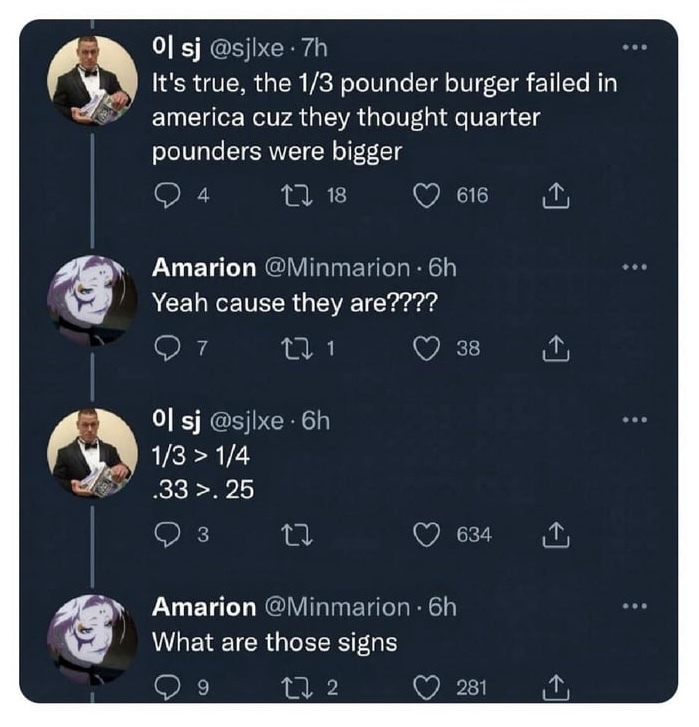this post was submitted on 14 Aug 2024
909 points (96.6% liked)
Facepalm
371 readers
1 users here now
Anything that makes you apply your hand to your face.
founded 4 months ago
MODERATORS
you are viewing a single comment's thread
view the rest of the comments
view the rest of the comments

I know there is a syntactically correct way that everyone knows and accepts, but it does depend on what the expression is.
Do you write it 5 > 3 or 3 < 5?
I don't understand your question, both of those are correct.
When I was in elementary school I knew how to use the signs but not how to read them. So I'd always read it as greater than and flip it. So 3 < 5 I would read out loud as "5 is greater than 3". My teacher quickly corrected me though. So it was only for like a week or so.
Well, that's a correct statement, you don't have to say "less than" to read that statement accurately.
Exactly, both of those statements convey the same information but are encoded in different ways.
To a foreigner, seeing the > < brackets may be more contextual than it is symbolic.
"To a foreigner"?
You know "<" and ">" aren't English expressions, right...?
You're arguing 6x3 or 3x6
They're the same
Yes, but if you have
5 > 3, you can read the ">" in two different ways:So which one is the correct way to spell out ">"? I also was confused about that for some time, since I was taught that the pointy end always points to the smaller number which is intuitive and can very easily be remembered, but I still had to memorize which symbol is pronounced as "less than" and which is pronounced as "greater than" until I realized that at least in every language I speak it's always read from left to right.
It still takes a bit of a second for me once in a while these days to remember the correct name for the signs when I see them.
The way my mind works is I find it faster to reconstruct the meaning every time rather than attempt to memorize which one is said which way.
Example: 3<5
My mind:
3 is the small number / 5 is the large number.
How do I say that in a sentence?
Three is less than five.
I do the math, not remember the definition.
I don't understand where you're coming from. In my mind it's so straight forward
If english is your first and main language, then there is no confusion mapping "less than" → <, and "greater than" → >.
If english is not your first and main language, then you might hesitate or ask for clarification on the symbols, or guess from the context.
At the end of the day, it really doesn't matter if you write
3 < 5or5 > 3, nor does it matter if you say "3 is less than 5" or "5 is greater than 3." Read it however you want, provided you convey accurate information.However, if you don't know the meaning of the symbol (i.e. if you see
x < yand aren't sure whether x or y is bigger), then we have a problem.We were always told < is less than. The symbol looks like an L for Less. If the L is facing the wrong way > it's greater than.
18 of one and a dozen and a half of the other.
no, those use the same operator. My example uses two different operators for the same result
3÷0.16666
They are expressed the same principles. I'd even say they are "encoded" in the same way.